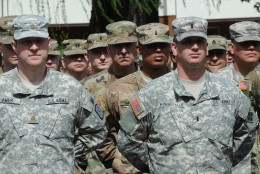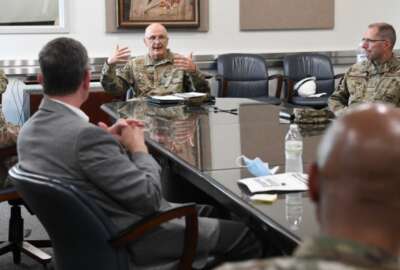
Are overseas bases worth the cost?
Stimson Center co-founder says budget would go further if it were geared for quickly sending forces to trouble spots rather than keeping them in one place.
Best listening experience is on Chrome, Firefox or Safari. Subscribe to Federal Drive’s daily audio interviews on Apple Podcasts or PodcastOne.
The U.S. has tens of thousands of troops permanently stationed overseas – mostly on bases that were established during the Cold War. But our next guest says if the goal of the forces is deterring adversaries, the Defense budget would go a lot further if it were geared toward quickly sending forces to trouble spots, rather than keeping them in places like Korea and Germany. Those conclusions, by the Stimson Center, are based on a study of more than 100 foreign policy crises. Barry Blechman is co-founder of the center, and one of the study’s coauthors. He spoke with Federal News Network’s Jared Serbu on Federal Drive with Tom Temin.
Interview transcript:
Barry Blechman: What we found was that when forces were moved into the region, that’s when we were effective. That’s when we were able to coerce foreign decision makers without having to go to war. When we relied on forces already in the region. For example, by drawing attention to forces we have in Germany, that was much less effective in getting people to do what we want them to do, or not to do what we didn’t want them to do.
Jared Serbu: When you say drawing attention, what do you mean that that’s that statement from the Pentagon or someone else just noting that we’ve got forces there, don’t try anything?
Barry Blechman: No, it has to be a physical chain. So they would go on deployment, or they would do a joint exercise with the poles, so there had to be a physical change in the disposition of the forces, whether a movement or a change in the alert status.
Jared Serbu: You say in a couple places in the article that those static forces that are permanently stationed overseas didn’t seem to deter adversaries. And it just seems like the word seem there is doing quite a bit of work because I think advocates of forward deployed forces would probably argue that look maybe Kim Jong Un wakes up every every single day thinking of all the bad things he’d like to do, but can’t because of the 40,000 US soldiers that are stationed just across the border.
Barry Blechman: Well, that’s the argument that’s always made for keeping forces there. We used to keep half a million troops in Europe, and that came down to 300,000. But for decades, we had 300,000 or so troops in Europe. And the argument was that this deterred the Russians from invading Western Europe. But we never found any evidence, this is a former study, that the Russians ever intended to invade Western Europe. I mean deterence is that thing you can never prove. You only know when it fails. There are reasons to keep troops in a region that familiarizes them with it. They get to operate more frequently with allies. So that’s all for the good, but it’s very expensive to do that. Because for these permanent deployments, they’re deployed with their families, and that means American style living quarters. It means schools, it means PXs, it means officer clubs, that means recreational facilities. It’s very expensive to do that. But it becomes part of the background. So when Kim Jong Un sees the troops down there, well, they’ve been there since 1953, and nothing has changed. But when we fly B-52s or B-1s along his coastline in response to some threat he made, that’s a change. That’s something that gets his attention because it’s a new kind of threat. It’s not the same old, same old.
Jared Serbu: So if the US were to switch to more of a fast deployment strategy that’s more conus based as you suggest here, I assume that’s something we couldn’t do overnight with the forces that we have today. What would the US actually need to build in order to have that fast deployment surge capability?
Barry Blechman: Well we’ve been moving that way for a while. We do these temporary deployments in Asia. The Marines go to Australia every year for an exercise and the Air Force deploys to Guam on a temporary basis. And similarly, in Europe, we’ve been sending Brigade Combat Teams into Eastern Europe for joint exercises. So these are just the soldiers alone without their families, with their equipment. And we have the transport to do it on a small scale, we’d have to build more deployment assets, we’d have to straighten out our tankers situation, you know with the scandal. Really, we’ve been flying these old airborne fuel tankers for years and modernizing them has been delayed forever. And most importantly, we’d have to improve the logistical facilities in Europe itself. We kind of let the facilities deteriorate when we drew down after the Cold War and we thought the Russians were going to be our friends. So we’d have to rebuild the military ports and the rail lines, which would get heavy equipment from the ports and from airfields to the front lines in Eastern Europe or what would be the front lines in Eastern Europe. Those are things that if we want the allies and the Germans specifically to spend more, those are things that we should be beating on them to do, rather than necessarily building more forces of their own.
Jared Serbu: Yeah, so for the most part, the facilities, the bases themselves actually stay, all of their logistics and medical and maintenance capabilities. But as far as large scale combat formations, they’re much more rotational locations rather than permanent basing locations.
Barry Blechman: Right. Like in Poland, for example, we will put divisional headquarters in some support units, but the battalions will rotate in, or brigades will rotate in and out. Similarly, with Air Forces, we permanently put some support units at airfields in Eastern Europe, in the Baltic countries, for example, and in Romania, but the squadrons, fighter squadrons, they go in for a few weeks, do an exercise and then come back home, where they’re based, where they’re families are. It’s cheaper that way and they still familiarize themselves with the potential battlefield and they still get the experience of working with the allied nations, you can accomplish the same thing.
Jared Serbu: One last question just on the issue of costs, would this really be a net cost savings? Because this approach isn’t free. You’re gonna work your carriers harder, you’re gonna work your Air Mobility fleets harder, probably need more assets, they’re going to be have to be maintained more often because you’re working them harder. How much money do you think he actually save in the end? Have you worked out the numbers?
Barry Blechman: No, we haven’t looked looked at the cost explicitly. That’s a good next step for us. But for the Naval Forces, the for the Marines and for the Air Forces, I don’t think it’d be much of a change. They’ve already shifted in that direction and carriers go out on a regular schedule and they stay for a long time, and they have since 9/11 really. The Air Force has been doing temporary deployments for well more than a decade, so I don’t think it would be an incremental cost for those two services. It would cost more for the Army which tends to be more sedentary and is harder to move given its heavy equipment. So that would be some an incremental cost. But it would also avoid all kinds of problems, like we have with local populations sometimes who resent having a bunch of Americans deployed there, particularly in Asia. We’ve had these problems with the Japanese forever, and the Koreans to a lesser extent. So I’m not sure where the balance comes out. But it wouldn’t be incremental costs for the Navy or the Air Force, it would only be for the ground forces. Interestingly, we found actually the most effective deployment was a Marine Amphibious group, because it’s an aircraft carrier the size of the Chinese aircraft carrier that we’re so worried about. We have eight of them. And we don’t count them as aircraft carriers, but they have these visco aircraft on them, which are quite capable and they carry a battalion landing team of Marines. So it’s quite a potent force and we found in terms of coursing other nations, sending one of these Marine groups in is is probably the most effective, had the best results of anything.
Copyright © 2025 Federal News Network. All rights reserved. This website is not intended for users located within the European Economic Area.
Tom Temin is host of the Federal Drive and has been providing insight on federal technology and management issues for more than 30 years.
Follow @tteminWFED
Related Stories






